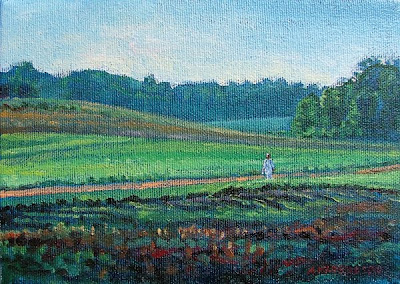The White Dress (oil on canvas 5 x 7 in.) SOLD!
10 July finds us on a farm south of Almonte Ontario. We come here every year, and I always enjoy the vista across this field, especially when someone is walking along the track, as people seem so small and precious in this big wide-open space.
In fact, a diversity of small things are becoming more precious here, as I learned when the farmer, whose pigs I was admiring, told me with pleasure that he'd noticed many red and black bugs on a Milkweed plant and takes it as a good sign - insects are coming back, in the third year after he took over the farm. He has changed the operations to pesticide-free, according to his farming practice in Alberta.
It is sunny, breezy, and 27C. Walking the path, we see a work in progress. On the south side low Corn grows among other Grasses and especially Lambsquarters (Chenopodium album). These are all pale from lack of nitrogen. On the north side, crusty bare soil supports a massive germination of Lambsquarters, among scattered big plants of Dandelion. A Vesper Sparrow sings in the distance. In the area pegged out by a low electric fence to confine the Pigs, the dandelions are gone, but there's scattered nearly-ripe Wheat, Lambsquarters, and Horseweed. In the clay soil around the pig's fence there's very precise boundaries between the nitrogen-dark and pale Lambsquarters. I look forward to visiting again with the new farmer of this place, to learn about the process of "going green" on an eastern Ontario farm.
We've always admired Horseweed, Conyza canadensis, since it was one of the primary weeds in the garden when we moved to Bishops Mills, so Fred looked it up on Wikipedia and discovered that this native North American species has evolved resistance to many of the most commonly used pesticides worldwide, and not only has it invaded agricultural fields in many parts of the world, becoming one of the 10 most important pesticide-resistant weeds, but it is able to transfer its pesticide resistance by hybridizing with its near relative C. ramosissima.
In fact, a diversity of small things are becoming more precious here, as I learned when the farmer, whose pigs I was admiring, told me with pleasure that he'd noticed many red and black bugs on a Milkweed plant and takes it as a good sign - insects are coming back, in the third year after he took over the farm. He has changed the operations to pesticide-free, according to his farming practice in Alberta.
It is sunny, breezy, and 27C. Walking the path, we see a work in progress. On the south side low Corn grows among other Grasses and especially Lambsquarters (Chenopodium album). These are all pale from lack of nitrogen. On the north side, crusty bare soil supports a massive germination of Lambsquarters, among scattered big plants of Dandelion. A Vesper Sparrow sings in the distance. In the area pegged out by a low electric fence to confine the Pigs, the dandelions are gone, but there's scattered nearly-ripe Wheat, Lambsquarters, and Horseweed. In the clay soil around the pig's fence there's very precise boundaries between the nitrogen-dark and pale Lambsquarters. I look forward to visiting again with the new farmer of this place, to learn about the process of "going green" on an eastern Ontario farm.
We've always admired Horseweed, Conyza canadensis, since it was one of the primary weeds in the garden when we moved to Bishops Mills, so Fred looked it up on Wikipedia and discovered that this native North American species has evolved resistance to many of the most commonly used pesticides worldwide, and not only has it invaded agricultural fields in many parts of the world, becoming one of the 10 most important pesticide-resistant weeds, but it is able to transfer its pesticide resistance by hybridizing with its near relative C. ramosissima.
The abstract quoted below shows a good example of why it is important to free our agricultural land from pesticides to reduce the chances of more species of weedy plants becoming seriously invasive.
Here is a picture of Fred feeding a handful of Lambsquarters to the pigs.
"Both C. ramosissima and C. canadensis are ubiquitous in disturbed habitats and play important roles in primary ecological successions; however, only C. canadensis is reported to reduce yields in row crops, serve as an alternate host for diverse pests, and limit grazing by reducing the palatability of pasture forages (Steyermark, 1963; Cronquist, 1980). Importantly, C. canadensis has evolved resistance to amide, bipyridilium, glycine, imidazolinone, sulfonylurea, and triazine herbicides in more than 10 countries worldwide and thus is considered one of the 10 most important herbicide-resistant weeds (Heap, 2006). Conzya ramosissima is found from North Dakota to Pennsylvania and south from New Mexico to Alabama in the United States, in southern Canada, and northern Mexico, while the more cosmopolitan C. canadensis is distributed throughout the Americas, West Indies, Europe, and Africa (Steyermark, 1963). Interestingly, the Conyza taxon represents the most successful case of intercontinental colonization of the Americas to the Old World, to the extent that C. canadensis and C. floribunda H.B.K. are probably the most widely distributed species throughout the world (Thébaud and Abbott, 199; Pruski and Sancho, 2006)."
(American Journal of Botany. 2007;94:660-673.)
© 2007 Botanical Society of America, Inc.
Reproductive Biology
Transfer of glyphosate resistance: evidence of hybridization in Conyza (Asteraceae)1
Ian A. Zelaya4, Micheal D. K. Owen and Mark J. VanGessel
2Iowa State University, Department of Agronomy, 2104 Agronomy Hall, Ames, Iowa 50011-1011 USA; 3University of Delaware, Department of Plant and Soil Sciences, Research and Education Center, 16684 County Seat Highway, Georgetown, Delaware 19947-9575 USA





Comments
Post a Comment
What do you think of this painting, and what do you know about the subject that I have painted?